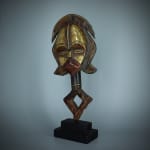Bakota Reliquary Guardian Figure (Mbulu Ngulu), 19th - early 20th century
Wood and brass
height 44 cm
height 17 3/8 in
height 17 3/8 in
GM.0100
Further images
The Kota (or Bakota) people live in the East and Southeast of Gabon – a smaller proportion also cross the border into the Congo. The original religion of the Kota...
The Kota (or Bakota) people live in the East and Southeast of Gabon – a smaller proportion also cross the border into the Congo. The original religion of the Kota people was a distinct ancestor cult: previously the deceased lay out in the forest, subsequently they were buried in the earth. After some time the skulls of important clan founders and chieftains were excavated and, as a sort of ‘second funeral’, were placed in large baskets with other remembrance pieces. These baskets were sealed and preserved in special huts, or ‘sacred shrines’. If the village was moved, the baskets containing the bones of the ancestors accompanied the tribe to the new village, where they constructed a new, special ‘shrine’. The link between the ancestors and the community was thus preserved, forming the very foundation of the worship and society of the Bakota people.
On each of these baskets containing the ancestor’s bones ‘sat’ a reliquary guardian figure, the ‘mbulu ngulu’ (‘reliquary basket with figure’). They were carved from wood and covered with hammered brass plates or copper discs. The figures towered over each basket. The lower diamond or lozenge-shaped base was bound to the baskets. The baskets were only brought out for important whole-village ceremonies. They were opened and their contents – the skulls of their ancestors – were presented, explained and ritually honoured. And so the venerated ancestors took part in the lives of their descendants. It is generally assumed that the ancestor cult of the Kota people, with its baskets and famous reliquary guardian figures, began in the 18th century and by roughly 1940 was extinct.
This stunning figure exhibits the typical oval-shaped face that is quintessential in Bakota art. The face is elegantly decorated with hammered brass plates. The plan of the face present a concave depression extending from the brows to the mouth, from which a rectangular nose emerges. The eyes are carved as slits, and the mouth is of triangular shape, enclosed into a rhomboidal convex section extending from the nose to the chin. The shape of the ears has been described in literature as "Extended elephant ears" with pendant earring of engraved metal strips. Crescent-shaped headdress, engraved along outer edge. The neck is decorated with three strips representing necklances.. Diamond-shaped lower portion of sculpture realised in wood and left uncovered.
Kota mbulu ngulu are unique among African sculptural forms in their combination of wood and hammered metal. Towards the end of the 19th century the first reliquary guardian figures came to Europe and became some of the most coveted collectors’ pieces within the field of African art, which they still are today. Kota mbulu ngulu figures are today exhibited in some of the most important collection of African Art in the world, such as the Metropolitan Museum of Art, the Museum of Fine Arts of Bostom, the Brooklyn Museum, and the Saint Louis Art Museum.
Dimensions given without mounting.
On each of these baskets containing the ancestor’s bones ‘sat’ a reliquary guardian figure, the ‘mbulu ngulu’ (‘reliquary basket with figure’). They were carved from wood and covered with hammered brass plates or copper discs. The figures towered over each basket. The lower diamond or lozenge-shaped base was bound to the baskets. The baskets were only brought out for important whole-village ceremonies. They were opened and their contents – the skulls of their ancestors – were presented, explained and ritually honoured. And so the venerated ancestors took part in the lives of their descendants. It is generally assumed that the ancestor cult of the Kota people, with its baskets and famous reliquary guardian figures, began in the 18th century and by roughly 1940 was extinct.
This stunning figure exhibits the typical oval-shaped face that is quintessential in Bakota art. The face is elegantly decorated with hammered brass plates. The plan of the face present a concave depression extending from the brows to the mouth, from which a rectangular nose emerges. The eyes are carved as slits, and the mouth is of triangular shape, enclosed into a rhomboidal convex section extending from the nose to the chin. The shape of the ears has been described in literature as "Extended elephant ears" with pendant earring of engraved metal strips. Crescent-shaped headdress, engraved along outer edge. The neck is decorated with three strips representing necklances.. Diamond-shaped lower portion of sculpture realised in wood and left uncovered.
Kota mbulu ngulu are unique among African sculptural forms in their combination of wood and hammered metal. Towards the end of the 19th century the first reliquary guardian figures came to Europe and became some of the most coveted collectors’ pieces within the field of African art, which they still are today. Kota mbulu ngulu figures are today exhibited in some of the most important collection of African Art in the world, such as the Metropolitan Museum of Art, the Museum of Fine Arts of Bostom, the Brooklyn Museum, and the Saint Louis Art Museum.
Dimensions given without mounting.











